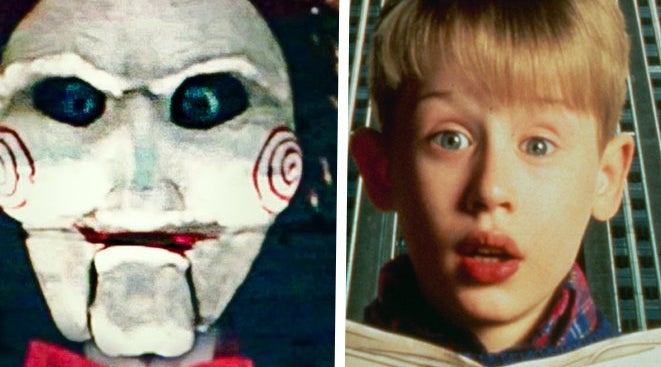
Do you want to hear a fan theory?
Of all the civilian-generated ideas about what really happened in famous films and TV shows, relatively few of them hit the perfect pitch of wackiness, nostalgia and evidence-backed accuracy as the theory that Kevin McCallister from “Home Alone” grew up to become Jigsaw, aka John Kramer, from the “Saw” horror movies.
On the surface, this theory just seems ridiculous. Jigsaw has his own backstory, along with a name that is definitely not Kevin McCallister.
Yet the viral theory, set forth in 2014 by Jason Concepcion of Grantland and The Ringer, points out a number of connections between Kevin and Jigsaw that — once you are made aware of them — are awfully difficult to un-know: They have comparable appearances (blond hair, blue eyes, similar jawlines). They share a penchant for “Rube Goldbergian Roadrunner-vs.-Coyote devices” (the crude traps Kevin sets for the Wet Bandits in “Home Alone” are eerily similar to the torture contraptions Jigsaw uses throughout the “Saw” series). And then there’s the shared fixation with basements: Kevin hallucinates in the lower reaches of his family’s home, mistaking a furnace for a monster ― an “obviously scarring childhood fear” that could also help explain the design and location of some of Jigsaw’s torture.
This last connection is made all the more terrifying by the fact that a Jigsaw-like clown mask appears in the basement of Kevin’s family home, too.
In a 2015 interview with HuffPost’s Todd Van Luling, Concepcion said these connections “just kind of clicked,” describing Kevin’s actions as those “of a supremely disturbed child.” For him, the parallels between the “Saw” franchise and the “Home Alone” movies “seemed obvious.”
Kevin himself, Macaulay Culkin, addressed the theory on “The Tonight Show” last year, giving fan theorists a rare golden stamp of approval. But Culkin, an actor, couldn’t really know the truth. For that, we had to go to director James Wan, the co-creator of “Saw.”
In a recent interview with HuffPost, Wan told me that he had indeed heard the theory, and he supports the fan speculation. “It’s amazing,” he said, laughing. “I should’ve known all along that Macaulay Culkin would grow up to be John Kramer.”
“I think it’s awesome,” he added. “I’m very flattered that people take the time to have fun with all these fan theories. I think that’s why I make these movies. I want the fans out there to have fun with them.”
I was happy to hear that Wan is into fan theories, because I proceeded to ask him more than a few other unanswered questions about his latest project, “Aquaman,” the Jason Momoa-led underwater adventure/EDM laser light show that also left me speculating.
What was the biggest challenge of bringing “Aquaman” to the screen?
This is a big film and there were obviously many challenges that go along with making big movies. I would say just the technicality of this film was one of the biggest challenges, trying to create — for more than half the movie — scenes that are underwater. That is a big task, and it is my first foray into a movie with a lot of visual effects.
There were a lot of effects in “Furious 7” as well, but this takes it to a whole different level, creating the underwater world, putting the actors on these really uncomfortable rigs to give the impression of floating underwater or swimming underwater, wasn’t easy. Using visual effects to finish off the environment like the floating hair, costumes and all that ― that took a long time to design, to shoot it and ultimately to finish the final look in postproduction.
What are the details that stuck out to you as important that viewers might not notice?
There’s a shot in the movie where Jason Momoa and Amber Heard’s characters swim into a sunken galley, and they step from a body of water into an air pocket in this ship. The way they come through, they go “thunk” and sort of step down. Then off to the corner, you just see this little crab stealing this gold coin and [it] moves out of shot. It doesn’t really affect the story, but it’s those little details that help us complete the world, and the world-building aspect of this movie is something that was very important to me.
You changed the underwater speaking from “Justice League,” which previously had Mera, Heard’s character, opening up an air pocket for her and Aquaman to talk while submerged.
Yeah, going into this I knew there would be a lot of underwater speaking, and obviously a lot of that was just going into a simplistic approach: Just don’t make a big deal about it. The Atlanteans would talk underwater in the same way you and I would talk on the surface world in air. But the only other thing I would bring to that is to remind the audience that they’re not speaking in air and treating their voices using acoustics to give the impression of underwater conversation. It’s that fine line of holding that aesthetic and not have it being too distracting.
In “Justice League,” we thought Arthur Curry/Aquaman traveled to Atlantis when he meets Mera. But in “Aquaman,” he apparently goes to Atlantis for the first time. So what’s happening there? Where was he in “Justice League”?
It wasn’t Atlantis. I spoke with Zack [Snyder, director of “Justice League,”] early on, and Zack mentioned that the location that Aquaman swims to in “Justice League” is an outpost. So when he told me that was his idea, I was like, “Oh great, then I can actually have Arthur go to Atlantis for the first time.” That’s very important for me, because he can go into it and have a wide-eyed approach to Atlantis and be in awe of it. I think that’s very important from a storytelling standpoint because the audience gets to experience Atlantis for the first time along with the character.
It wouldn’t be the same if Arthur goes to Atlantis and he’s been here before and he’s kind of jaded about it. There’s nothing impressing him. Then you as an audience watching would not be impressed either. It’s that Spielberg approach, right? Seeing a character seeing something for the first time ― like in “Jurassic Park” when Laura Dern sees the dinosaur for the first time. The camera is pushing in on her look of awe and wonderment. That’s how you convey it to the audience and that’s how the audience comes along with the characters.
Speaking of the characters, one of them that had the internet talking even before the movie came out was the drum-playing octopus. What’d you think of that reaction?
That’s a little cameo ― it’s not an Easter egg, it’s a cameo ― of a character from the comic book called Topo. If you Google “topo aquaman,” you see all these really goofy characters of this octopus playing musical instruments. So I’m like, “OK, how do I take that and bring it into my movie and make it cool?” It just makes it fun right off the bat. When you see that you’re like, “Wow, I’m in a different kind of superhero movie.”
What’s it like directing Jason Momoa in fight sequences, one of which involves a very Khal Drogo-like injury from Black Manta?
It’s great directing Jason just in general, but especially when it comes to physicality like action stuff. He’s such a physical guy. He really takes the time and effort, and he’s really passionate about how he moves and the choreography. We had a great stunt department come in here that works closely with Jason, and I worked closely with the stunt team to design action scenes that we haven’t quite seen before. I’m a big fan of action movies, though most people know me for my horror films. But I’m such a lover of action set pieces, and I always try to create suspenseful action pieces that haven’t been seen before or seen in a way that I can photograph it in a unique way.
How do you feel about Julie Andrews skipping out on the “Mary Poppins” reboot but cameoing in “Aquaman,” which opens the same weekend?
Obviously I definitely see the irony there. I don’t know what to say about that other than going into the casting of the most powerful creature on this planet, I wanted it to be a female. And I wanted her to be British, for some reason. For some reason in my head, I’m like the most powerful creature is a dame and she’ll be very classy. So naturally someone like Julie’s name came up.
In previous DC Universe movies, we’ve had cameos from other Justice League members. Was that ever in the plans?
No, I just feel like this is his stand-alone movie, just let it be about Aquaman. I feel like all the other characters have had so many movies; audiences have known all the other characters in all the other movies, all these different projects. Let this be Aquaman’s time in the spotlight.
